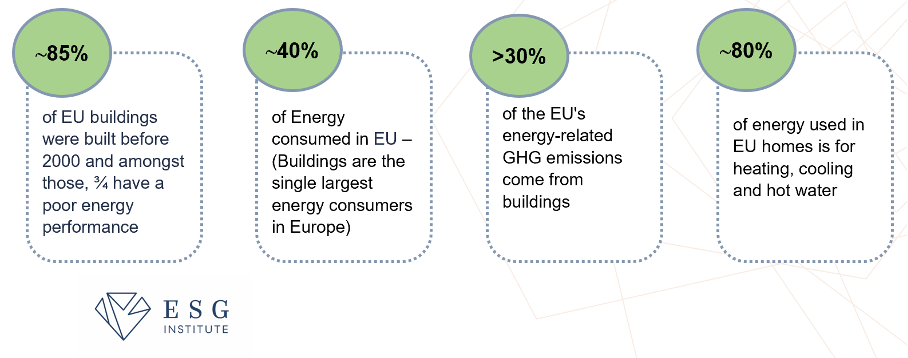Transforming Europe’s building sector toward energy efficiency and sustainability: Europe’s new Legislation – The Energy Performance of Buildings Directive (EU/2024/1275)
June 28th ,2024
By Anna Barbaruk

What is the energy performance of building?
The energy performance of a building is a critical factor in monitoring how much energy the building consumes, as well as the extent of the building's emissions of polluting greenhouse gas into the environment.
Background - some facts about the buildings in EU:
According to information on the European Commission's energy site (data from Eurostat 2023 inventory), buildings are the single largest energy consumer in Europe, a large part of them have poor energy performance and the annual energy renovation rate is only about 1% (few statistics are mentioned below).

EU’s ambitious Energy Goals and The EU’s Energy Performance of Buildings Directive:
In pursuit of the European Union’s ambitious energy and climate objectives under the European Green Deal, new legislative initiative has emerged: the Energy Performance of Buildings Directive (EU/2024/1275) which aim to improve the energy efficiency of buildings and to increase the rate of renovation in the EU particularly for the worst-performing buildings in each country but is taking into account national specifies. Together with revised Energy Efficiency Directive (EU/2023/1791) and other policies of Green Deal Package they aim to help to achieve a fully decarbonized building stock by 2050. The directive boosts Europe’s energy independence, encourages the phase-out of fossils fuels and makes “zero-emission” the standard for new building.
Key objectives of the revised directive:
-
Increased Renovation Rate:
The directive encourages increased renovation rates (aims to double it by 2030) especially for poorly performing buildings in each country. For residential buildings, the directive targets a 16% reduction in energy use by 2030 and a 20-22% reduction by 2035, and for non-residential buildings 16% of the worst-performing buildings will have to be renovated by 2030 and the 26% worst-performing buildings by 2033. Member States will have the possibility to exempt certain categories of residential and non-residential buildings from these obligations, including historical buildings or holiday homes. -
Improved Air Quality:
The directive supports measures to enhance air quality within buildings. -
Digitalized energy system:
The directive encourages the adoption of digital technologies for energy management in buildings. Smart meters, building automation systems, and energy-efficient appliances are to play a crucial role. -
Sustainable Mobility Infrastructure:
It promotes the rollout of infrastructure for sustainable mobility, aligning with broader environmental goals. Electric vehicle charging stations and bike-friendly facilities will contribute to this objective. -
Climate Ambition:
It contributes to reaching at least 60% emission reductions in the building sector by 2030 comparing to 2015 and a zero-emission building stock by 2050.
Recognizing differences across EU countries, the directive allows governments to decide on renovation measures best-suited to their specific national context. Countries can also exempt certain buildings, including historical buildings and holiday homes.
The Energy Performance of Buildings Directive outlines several strategies to achieve its objectives:

-
1. Renovation Strategies:
Member states are encouraged to develop long-term renovation strategies for their building stock. These strategies should prioritize energy-efficient renovations, especially for the worst-performing buildings. The directive also proposes the Building Renovation Passports:- These passports serve as guides for building owners during staged and deep energy renovations.
- They provide a roadmap for improving energy efficiency, helping owners make informed decisions.
-
2. Minimum Energy Performance Standards:
The directive sets minimum energy performance standards for new and existing buildings. These standards aim to reduce energy consumption and greenhouse gas emissions. The minimum requirements for energy performance have been successively increased since 2009. This is due to advances in construction, installation technology and energy generation technology, increasing user requirements and policies aimed at the rational use of energy. -
3. Smart Technologies and Digitalization:
The directive promotes the use of smart technologies and digital solutions which can enhance energy efficiency. This includes smart meters, building automation systems, and energy management tools. -
4. Promotion of Renewable Energy Sources:
The directive encourages the integration of renewable energy sources in buildings. This can be achieved through solar panels, heat pumps, and other sustainable technologies. When it comes to solar panels directive encourages the use of solar technologies in buildings and new buildings should be designed to be “solar-ready,” facilitating future solar installations. -
5. Support for Energy-Poor Households:
Measures should be taken to address energy poverty. Financial incentives, grants, and support programs can help vulnerable households improve their building energy performance. As the directive initiates a gradual phase-out of boilers powered by fossil fuels, the subsidies for stand-alone fossil fuel boilers will end starting from January 1, 2025. -
6. Monitoring and Reporting:
Regular monitoring and reporting on progress are essential. Member states need to track energy performance improvements and adjust strategies accordingly.
What are the steps to take to comply with the Energy Performance of Buildings Directive (EPBD):
-
Energy Audits:
Conduct energy audits to assess the building’s energy performance. These audits help identify areas for improvement and prioritize energy-saving measures. Obtain an Energy Performance Certificate (EPC) when selling, renting, or constructing a building. -
Renovation and Upgrades:
- Insulation: Improve insulation to reduce heat loss or gain.
- Lighting: Switch to energy-efficient lighting (LEDs).
- HVAC Systems: Upgrade heating, ventilation, and air conditioning systems.
- Windows and Doors: Opt for energy-efficient windows and doors.
-
Monitoring and Control:
- Smart Meters: Install smart meters to track energy consumption.
- Building Management Systems (BMS): Implement BMS for better control over energy use.
-
Renewable Energy Sources:
- Solar Panels: Consider installing solar panels to generate clean energy.
- Geothermal Heat Pumps: Use geothermal systems for heating and cooling.
- Certification and Compliance:
- Obtain an Energy Performance Certificate (EPC) to demonstrate compliance.
- Ensure compliance with national regulations and deadlines.
In summary, the analysis of the new directive shows that it aims at energy efficiency in buildings through a variety of regulations. Alongside regulations shaping building energy standards and stimulating and obliging improvements, there are requirements for the provision of energy efficiency information, as well as solutions to support the energy efficiency improvement process. The adoption of the new Energy Performance of Buildings Directive (EPBD) will have a strong impact on the construction market and the construction industry has a lot of work ahead of it to adapt to the new regulations and to acquire modern knowledge on how to design and build to modern standards.
If you need support in your journey toward compliance with the Energy Performance of Buildings Directive (EPBD) please contact us.
Sources: